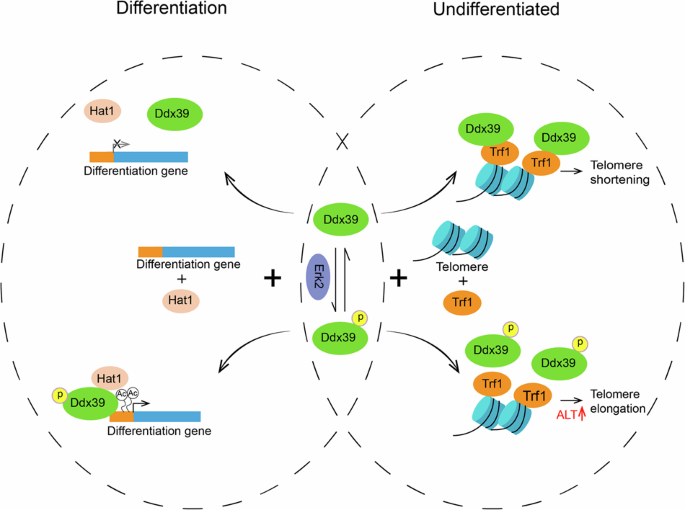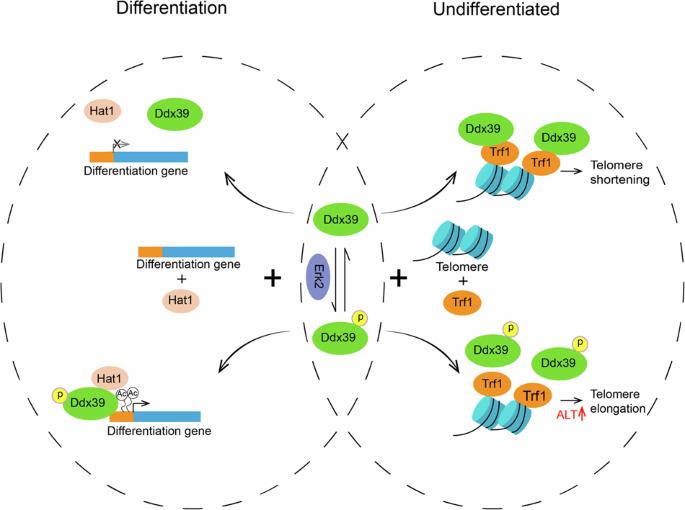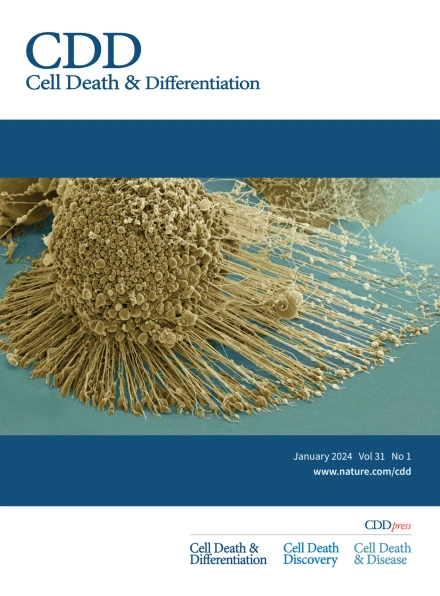Ddx39 在胚胎干细胞分化和端粒长度调节中的新作用
IF 13.7
1区 生物学
Q1 BIOCHEMISTRY & MOLECULAR BIOLOGY
引用次数: 0
摘要
Erk信号对于小鼠胚胎干细胞(ESC)的自我更新和分化以及端粒稳态是不可或缺的。但Erk如何调控这些生物学过程仍不清楚。我们通过共免疫沉淀和质谱分析鉴定了132个Erk2相互作用蛋白,并重点研究了作为Erk2潜在底物的Ddx39。我们证明了Erk2能使Ddx39在Y132和Y138上磷酸化。Ddx39基因敲除(KO)的ESC在分化过程中会出现H3K27ac水平降低,从而导致分化缺陷。Ddx39的磷酸化会促进Hat1的招募,使H3K27乙酰化并激活分化基因。此外,Ddx39 KO会导致ESC端粒延长。Ddx39被端粒结合蛋白Trf1招募到端粒上,从而破坏了Trf1形成的DNA环,抑制了端粒的替代性延长(ALT)。Ddx39 的磷酸化削弱了它与 Trf1 的相互作用,使其从端粒中释放出来。因此,ALT 活性增强,端粒延长。总之,我们的研究揭示了 Ddx39 在造血干细胞的分化和端粒稳态中的重要作用。本文章由计算机程序翻译,如有差异,请以英文原文为准。


Novel role for Ddx39 in differentiation and telomere length regulation of embryonic stem cells
Erk signaling is indispensable for the self-renewal and differentiation of mouse embryonic stem cells (ESCs), as well as telomere homeostasis. But how Erk regulates these biological processes remains unclear. We identified 132 Erk2 interacting proteins by co-immunoprecipitation and mass spectrometric analysis, and focused on Ddx39 as a potential Erk2 substrate. We demonstrated that Erk2 phosphorylates Ddx39 on Y132 and Y138. Ddx39 knockout (KO) ESCs are defective in differentiation, due to reduced H3K27ac level upon differentiation. Phosphorylation of Ddx39 promotes the recruitment of Hat1 to acetylate H3K27 and activate differentiation genes. In addition, Ddx39 KO leads to telomere elongation in ESCs. Ddx39 is recruited to telomeres by the telomere-binding protein Trf1, consequently disrupting the DNA loop formed by Trf1 and suppressing the alternative lengthening of telomeres (ALT). Phosphorylation of Ddx39 weakens its interaction with Trf1, releasing it from telomeres. Thus, ALT activity is enhanced, and telomeres are elongated. Altogether, our studies reveal an essential role of Ddx39 in the differentiation and telomere homeostasis of ESCs.
求助全文
通过发布文献求助,成功后即可免费获取论文全文。
去求助
来源期刊

Cell Death and Differentiation
生物-生化与分子生物学
CiteScore
24.70
自引率
1.60%
发文量
181
审稿时长
3 months
期刊介绍:
Mission, vision and values of Cell Death & Differentiation:
To devote itself to scientific excellence in the field of cell biology, molecular biology, and biochemistry of cell death and disease.
To provide a unified forum for scientists and clinical researchers
It is committed to the rapid publication of high quality original papers relating to these subjects, together with topical, usually solicited, reviews, meeting reports, editorial correspondence and occasional commentaries on controversial and scientifically informative issues.
 求助内容:
求助内容: 应助结果提醒方式:
应助结果提醒方式:


